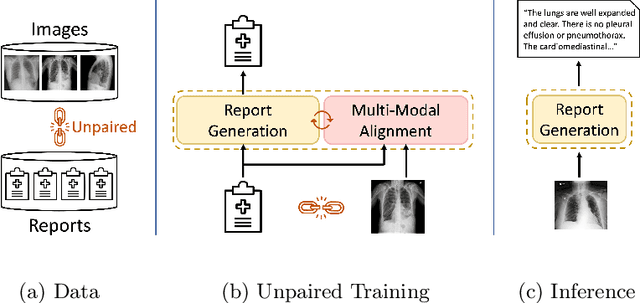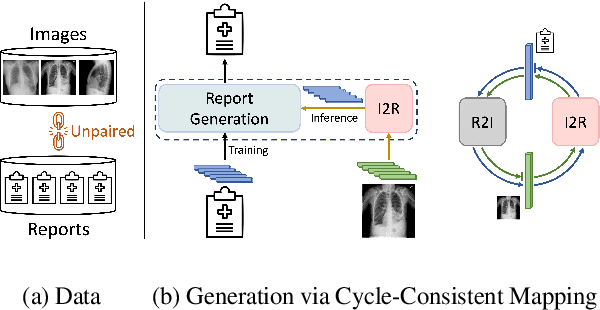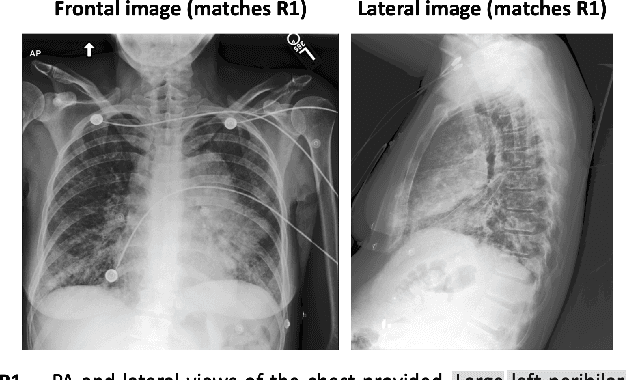Gefen Dawidowicz
Image-aware Evaluation of Generated Medical Reports
Oct 22, 2024



Abstract:The paper proposes a novel evaluation metric for automatic medical report generation from X-ray images, VLScore. It aims to overcome the limitations of existing evaluation methods, which either focus solely on textual similarities, ignoring clinical aspects, or concentrate only on a single clinical aspect, the pathology, neglecting all other factors. The key idea of our metric is to measure the similarity between radiology reports while considering the corresponding image. We demonstrate the benefit of our metric through evaluation on a dataset where radiologists marked errors in pairs of reports, showing notable alignment with radiologists' judgments. In addition, we provide a new dataset for evaluating metrics. This dataset includes well-designed perturbations that distinguish between significant modifications (e.g., removal of a diagnosis) and insignificant ones. It highlights the weaknesses in current evaluation metrics and provides a clear framework for analysis.
MedRAT: Unpaired Medical Report Generation via Auxiliary Tasks
Jul 04, 2024



Abstract:Generating medical reports for X-ray images is a challenging task, particularly in an unpaired scenario where paired image-report data is unavailable for training. To address this challenge, we propose a novel model that leverages the available information in two distinct datasets, one comprising reports and the other consisting of images. The core idea of our model revolves around the notion that combining auto-encoding report generation with multi-modal (report-image) alignment can offer a solution. However, the challenge persists regarding how to achieve this alignment when pair correspondence is absent. Our proposed solution involves the use of auxiliary tasks, particularly contrastive learning and classification, to position related images and reports in close proximity to each other. This approach differs from previous methods that rely on pre-processing steps using external information stored in a knowledge graph. Our model, named MedRAT, surpasses previous state-of-the-art methods, demonstrating the feasibility of generating comprehensive medical reports without the need for paired data or external tools.
MedCycle: Unpaired Medical Report Generation via Cycle-Consistency
Mar 21, 2024



Abstract:Generating medical reports for X-ray images presents a significant challenge, particularly in unpaired scenarios where access to paired image-report data for training is unavailable. Previous works have typically learned a joint embedding space for images and reports, necessitating a specific labeling schema for both. We introduce an innovative approach that eliminates the need for consistent labeling schemas, thereby enhancing data accessibility and enabling the use of incompatible datasets. This approach is based on cycle-consistent mapping functions that transform image embeddings into report embeddings, coupled with report auto-encoding for medical report generation. Our model and objectives consider intricate local details and the overarching semantic context within images and reports. This approach facilitates the learning of effective mapping functions, resulting in the generation of coherent reports. It outperforms state-of-the-art results in unpaired chest X-ray report generation, demonstrating improvements in both language and clinical metrics.
LIMITR: Leveraging Local Information for Medical Image-Text Representation
Mar 21, 2023



Abstract:Medical imaging analysis plays a critical role in the diagnosis and treatment of various medical conditions. This paper focuses on chest X-ray images and their corresponding radiological reports. It presents a new model that learns a joint X-ray image & report representation. The model is based on a novel alignment scheme between the visual data and the text, which takes into account both local and global information. Furthermore, the model integrates domain-specific information of two types -- lateral images and the consistent visual structure of chest images. Our representation is shown to benefit three types of retrieval tasks: text-image retrieval, class-based retrieval, and phrase-grounding.
 Add to Chrome
Add to Chrome Add to Firefox
Add to Firefox Add to Edge
Add to Edge